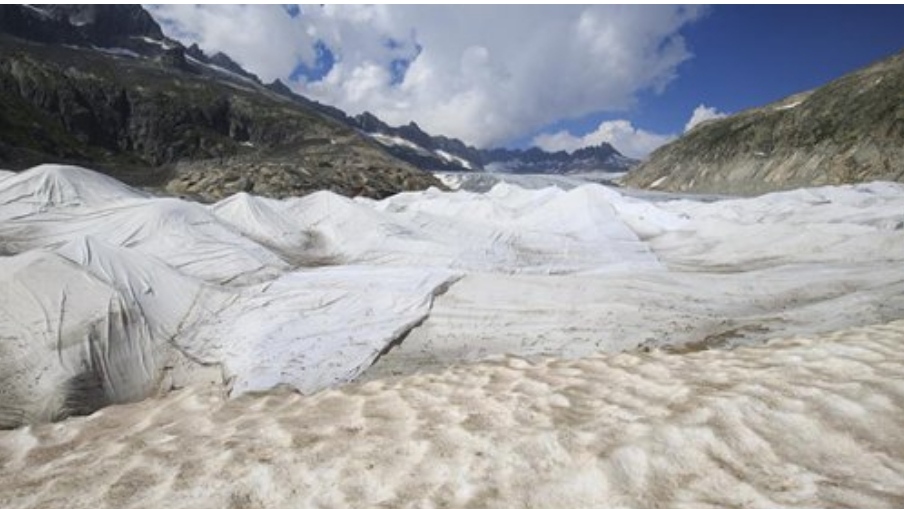Earth’s ‘vital signs’ keep worsening as humanity’s impact deepens

Photo taken on Aug. 5, 2018 shows the Rhone Glacier covered with white blankets near the Furka Pass in Switzerland. The Rhone Glacier is protected by special white blankets to prevent it from further melting as a result of global warming.
The global economy’s business-as-usual approach to cope with climate change has seen Earth’s “vital signs” deteriorate to record levels, an influential group of scientists said Wednesday.
They warned that several climate tipping points were now imminent.
The researchers, part of a group of more than 14,000 scientists who have signed on to an initiative declaring a worldwide climate emergency, said that governments had consistently failed to address the root cause of climate change: “the overexploitation of the Earth.”
Since a similar assessment in 2019, they noted an “unprecedented surge” in climate-related disasters, including flooding in South America and Southeast Asia, record-shattering heat waves and wildfires in Australia and the US, and devastating cyclones in Africa.
Of 31 “vital signs,” key metrics of planetary health that include greenhouse gas emissions, glacier thickness, sea-ice extent and deforestation, they found that 18 hit record highs or lows.
For example, despite a dip in pollution linked to the pandemic, levels of atmospheric carbon dioxide and methane hit all-time highs in 2021.
Greenland and Antarctica both recently showed all-time low levels of ice mass, and glaciers are melting 31 percent faster than they did just 15 years ago, the authors said.
Both ocean heat and global sea levels set new records since 2019, and the annual loss rate of the Brazilian Amazon reached a 12-year high in 2020.
Echoing previous research, they said that forest degradation linked to fire, drought and logging was causing parts of the Brazilian Amazon to now act as a source of carbon, rather than absorb the gas from the atmosphere. Livestock are now at record levels, numbering more than 4 billion and with a mass exceeding that of all humans and wild land mammals combined, they said.
The researchers said there was “mounting evidence that we are nearing or have already crossed” a number of climate tipping points.
“Given these alarming developments, we need short, frequent, and easily accessible updates on the climate emergency,” said the study, published in the journal BioScience.
A draft report from the UN’s climate science advisory panel offers the most exhaustive look yet at how our warming planet will impact humankind’s health, wealth and well-being.
The Intergovernmental Panel on Climate Change (IPCC) draft, is set to be published in 2022.
Here are some of its findings on impacts on people:
The report shows how climate change has already decreased major crop production globally and is predicted to impact yields throughout the 21st century, putting greater pressure on countries with a growing number of mouths to feed.
Between 2015 and 2019, an estimated 166 million people, primarily in Africa and Central America, required humanitarian assistance due to climate-related food emergencies.
Rising levels of carbon dioxide will also degrade the quality of crops, reducing vital minerals and nutrients in key foodstuffs.
Despite greater levels of socioeconomic development, nearly 10 million more children will go undernourished and stunted by 2050 – exposing them to a lifetime of associated health risks.
Catch potential of marine fisheries – on which millions of people rely as their main protein source – is projected to fall 40 to 70 percent for tropical regions of Africa if emissions continue unabated.
Halving red meat consumption and doubling intake of nuts, fruits and vegetables could reduce food-related emissions as much as 70 percent by mid-century and save 11 million lives by 2030.
Rising temperatures will reduce people’s ability to work, with much of South Asia, sub-Saharan Africa and parts of Central and South America losing up to 250 working days a year by 2100.
An additional 1.7 billion people will be exposed to severe heat and an additional 420 million people subjected to extreme heat waves if the planet warms by 2 C compared to 1.5 C – the range laid out in the Paris Agreement.
By 2080, hundreds of millions of city dwellers in sub-Saharan Africa and South and Southeast Asia could face over 30 days of deadly heat each year.
Flooding on average will likely displace 2.7 million people annually in Africa. Without emissions cuts, more than 85 million people could be forced to leave their homes in sub-Saharan Africa due to climate induced impacts by 2050.
A plus 1.5-C world would see two or three times more people affected by floods in Colombia, Brazil and Argentina, four times more in Ecuador and Uruguay, and a five-fold jump in Peru.
Some 170 million people are expected to be hit by extreme drought this century if warming reaches 3 C.
The number of people in Europe at high risk of mortality will triple with 3 C warming compared to 1.5 C warming.
As rising temperatures expand the habitat of mosquitoes, by 2050 half of the world’s population is predicted to be at risk of vector-borne diseases such as dengue fever, yellow fever and Zika virus.




